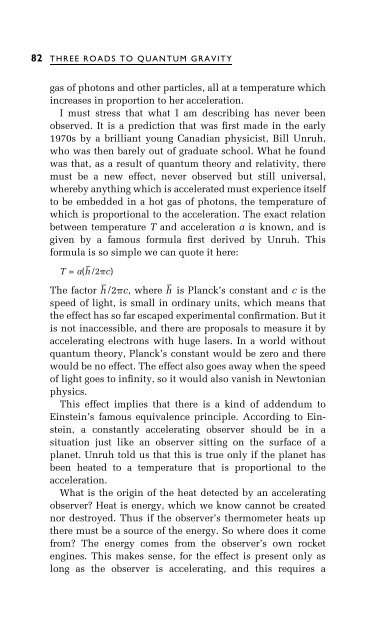Three Roads To Quantum Gravity
Three Roads To Quantum Gravity
Three Roads To Quantum Gravity
Create successful ePaper yourself
Turn your PDF publications into a flip-book with our unique Google optimized e-Paper software.
82 THREE ROADS TO QUANTUM GRAVITY<br />
gas of photons and other particles, all at a temperature which<br />
increases in proportion to her acceleration.<br />
I must stress that what I am describing has never been<br />
observed. It is a prediction that was ®rst made in the early<br />
1970s by a brilliant young Canadian physicist, Bill Unruh,<br />
who was then barely out of graduate school. What he found<br />
was that, as a result of quantum theory and relativity, there<br />
must be a new effect, never observed but still universal,<br />
whereby anything which is accelerated must experience itself<br />
to be embedded in a hot gas of photons, the temperature of<br />
which is proportional to the acceleration. The exact relation<br />
between temperature T and acceleration a is known, and is<br />
given by a famous formula ®rst derived by Unruh. This<br />
formula is so simple we can quote it here:<br />
T = a(h Å /2pc)<br />
The factor h Å /2pc, where h Å is Planck's constant and c is the<br />
speed of light, is small in ordinary units, which means that<br />
the effect has so far escaped experimental con®rmation. But it<br />
is not inaccessible, and there are proposals to measure it by<br />
accelerating electrons with huge lasers. In a world without<br />
quantum theory, Planck's constant would be zero and there<br />
would be no effect. The effect also goes away when the speed<br />
of light goes to in®nity, so it would also vanish in Newtonian<br />
physics.<br />
This effect implies that there is a kind of addendum to<br />
Einstein's famous equivalence principle. According to Einstein,<br />
a constantly accelerating observer should be in a<br />
situation just like an observer sitting on the surface of a<br />
planet. Unruh told us that this is true only if the planet has<br />
been heated to a temperature that is proportional to the<br />
acceleration.<br />
What is the origin of the heat detected by an accelerating<br />
observer? Heat is energy, which we know cannot be created<br />
nor destroyed. Thus if the observer's thermometer heats up<br />
there must be a source of the energy. So where does it come<br />
from? The energy comes from the observer's own rocket<br />
engines. This makes sense, for the effect is present only as<br />
long as the observer is accelerating, and this requires a



![arXiv:1001.0993v1 [hep-ph] 6 Jan 2010](https://img.yumpu.com/51282177/1/190x245/arxiv10010993v1-hep-ph-6-jan-2010.jpg?quality=85)


![arXiv:1008.3907v2 [astro-ph.CO] 1 Nov 2011](https://img.yumpu.com/48909562/1/190x245/arxiv10083907v2-astro-phco-1-nov-2011.jpg?quality=85)








![arXiv:1002.4928v1 [gr-qc] 26 Feb 2010](https://img.yumpu.com/41209516/1/190x245/arxiv10024928v1-gr-qc-26-feb-2010.jpg?quality=85)
![arXiv:1206.2653v1 [astro-ph.CO] 12 Jun 2012](https://img.yumpu.com/39510078/1/190x245/arxiv12062653v1-astro-phco-12-jun-2012.jpg?quality=85)
